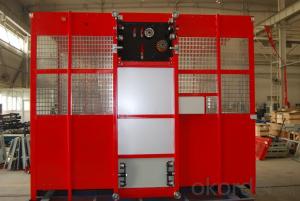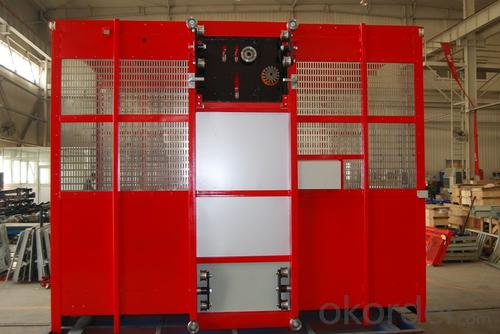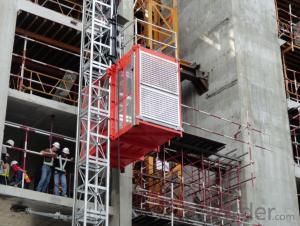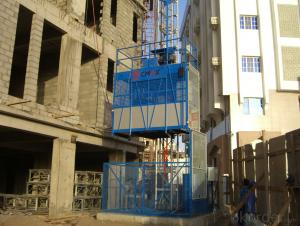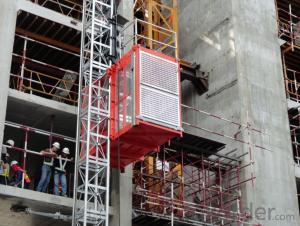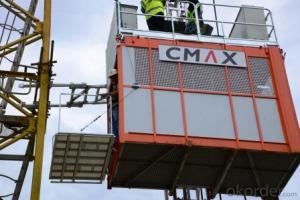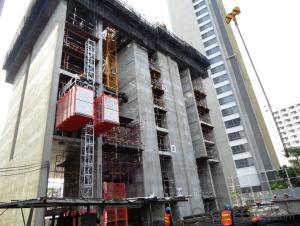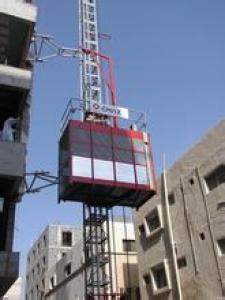TWIN CAGE CONSTRUCTION LIFT ELEVATOR HOIST MODEL SC320/320G
- Loading Port:
- Guangzhou
- Payment Terms:
- TT OR LC
- Min Order Qty:
- 1 unit
- Supply Capability:
- 100 unit/month
OKorder Service Pledge
OKorder Financial Service
You Might Also Like
Specification
BASIC SPECIFICATION:
CMAX SC320/320G (TWIN CAGE)
WORKING HEIGHT: 250M
PAYLOAD: 2X3200KG
RATED INSTALLATION LOAD: 2 X 1000KG
NORD MOTOR, 2X3X18.5KW
WITH VFD SPEED CONTROL (SIEMENS, 2X110KW), 0~63M/MIN
CAGE 2 X (3.2X1.5X2.1m)
MAST SECTION (650x650x1508mm), 93pcs with 4.5mm thickness, 73pcs with 6.3mm thickness
TYPE II MAST TIE-INS(2.9-3.6m), 41pcs
WITH:
▪ Cable Trolley
▪ Safety Device
▪ Hot deep galvanized Cages, Mast Tie-ins (Type II), Mast Sections and Enclosure
The general building hoist manufactured by our company have the features as good quality, long life, wide application range and convenient for maintenance, the gering adopts imported bearing, enameled cable, and oil seal, the electric parts adopt products from world renowned manufactures such as Schneider, Siemens, and LG, the racks and pinion adopts special material and heat-treatment technique, which prolong the life of these parts. The steel structure uses quality steel from famous domestic manufacturers, the surface of the structure can apply paint-spray, Parkerizing baking finish or hot galvanizing processing according to users requirements, the cage can be produced and decorated by aluminum molded board, punched-plate or figured aluminum board.
ADVANTAGES:
1. Our own systems of production engineering.
2. Production design from the concept to the engineering details.
3. Technical experts with great experience in the sector.
4. Continuous development of new solutions and products adapted to the requirements of our clients.
5. Methodology and project procedure administration in compliance with current guidelines.
6. Extensive worldwide commercial network
TABLE OF SPECIFICATION (FOR REFERENCE):
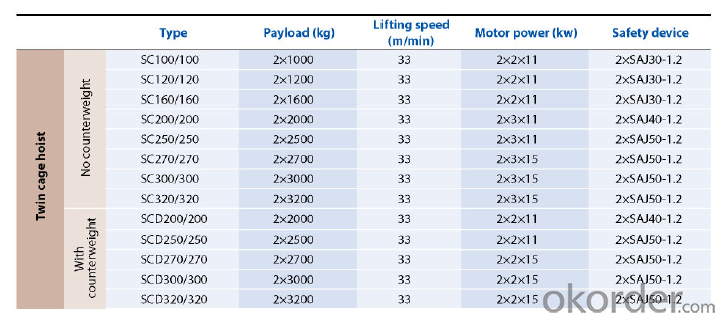
FAQ
1. WHY US?
China National Building Materials (Group) Corporation (CNBM), established in 1984,now is one of the largest state-owned group corporation in China, dealing with building materials & industrial equipment. Up to year 2010, CNBM Group's total asset is 20 billion USD and total staff is more than 100,000.CNBM International Corporation, specializes in designing & manufacturing of various
kinds of construction machinery, including tower crane, building hoist, etc. All the equipment produced by CNBM are compliant with the National level quality standard, and wins great reputation for their endurable performance in worldwide markets.
2. WHAT IS THE PRODUCTION AND SHIPMENT SCHEDULE?
Our hoists are normally ready to be shipped within 30 days. The goods are packed nude and in wooden boxes and are placed inside containers.
3. DO WE OFFER AFTER SALES SERVICE?
We offer the Preventative Maintenance and After Sales Service. For we strongly feels about the importance of supporting our customers and the product solutions we provide. Consequently we offer comprehensive maintenance options to prevent equipment issues before they become problems. Also we offer one year guarantee period.
- Q: Safe use of construction elevator
- In the case of passenger and carriage, the loading shall be uniformly distributed, and the overload shall be strictly prohibited. When the elevator runs to the top and lowest levels, it is strictly forbidden to stop at the collision or lower limit. 7. The driver for leaving hanging basket and while going off work, should be hanging basket fell to the ground, to cut off the total power supply, and the door is locked point, prevent other undocumented workers start the hoisting cage without authorization. Wind up above 6, should stop using the elevator and bring the cage down to the ground. There must be good protection on both sides of the transportation channel. Floor door should be in a normally closed state, its height should conform to the requirements of the specification, anyone shall not open or head out of the door, when the floor door open, the driver shall not start the elevator. Ensure that the communication device is in good condition and the driver should be able to start the lift after confirming the signal. The driver should immediately execute any emergency stop signal on the floor of the operation. The elevator should be installed on a separate ground protection and lightning protection device. It is strictly forbidden to do maintenance work under the condition of the elevator. If maintenance is required, the power supply must be cut off and the sign of "check in, shut off" will be hung in a prominent place.
- Q: A building hoist is a mechanical device used in construction to lift materials and sometimes workers vertically. It is essential for the efficient movement of materials in high-rise construction.
- <p>The function of a building hoist is to facilitate the vertical transportation of materials, equipment, and sometimes workers within a construction site. It is particularly useful in high-rise buildings where manual lifting would be inefficient and unsafe. A building hoist allows for the rapid and safe movement of materials, reducing labor costs and improving construction speed.</p>
- Q: Is the elevator detail a construction plan? Do you have a detailed picture of the elevator?
- There is a detailed picture of the elevator. The structure of the elevator well and the layout of the embedded parts.
- Q: What are the benefits and drawbacks of utilizing a building hoist in construction?
- <p>Advantages of using a building hoist include increased efficiency in material transportation, reduced manual labor, and improved safety by minimizing the risk of accidents associated with manual handling. They can also speed up construction timelines by allowing for continuous material flow. Disadvantages include the initial cost of the hoist, the need for regular maintenance, and potential downtime in case of mechanical failure. Additionally, building hoists may have limited capacity and may not be suitable for all types of construction projects, especially those with irregular shapes or limited space for installation.</p>
- Q: This question asks about the various elements that can influence the efficiency and effectiveness of a building hoist.
- <p>The performance of a building hoist is affected by several factors including the type and weight of materials being lifted, the frequency of use, the hoist's mechanical condition and maintenance, environmental conditions such as wind and temperature, the skill and training of operators, and the design and capacity of the hoist itself. Proper installation, regular inspections, and adherence to safety protocols also play a crucial role in ensuring optimal performance and safety. Additionally, the quality of electrical systems, the efficiency of the drive mechanism, and the structural integrity of the hoist's components can significantly impact its operation.</p>
- Q: This question inquires whether a building hoist can be utilized in both indoor and outdoor environments, particularly in areas with limited space.
- <p>Yes, building hoists can be used both indoors and outdoors, but their suitability depends on the specific model and design. Some hoists are specifically engineered for indoor use due to their compact size and lower weight capacity, while others are designed for outdoor use and can handle heavier loads. In limited spaces, it's crucial to select a hoist with a small footprint and high lifting capacity relative to its size. Always ensure that the hoist meets the required safety standards and is operated by trained personnel to prevent accidents in confined spaces.</p>
- Q: Is it permissible to use a building hoist for the purpose of lifting hazardous materials?
- <p>A building hoist is typically not designed for lifting dangerous materials. It is meant for the transportation of construction materials and personnel within a building. Lifting hazardous materials requires specialized equipment and procedures to ensure safety. Always refer to the manufacturer's guidelines and local regulations for the appropriate use of hoisting equipment and handling of dangerous materials.</p>
- Q: How many meters or how many layers should the construction elevator be installed?
- Construction elevator is also called construction lifter, alias outdoor elevator or people dual-purpose ladder. The country is not clear how many meters or how many layer must be used, but in some coastal developed cities are now more than 30 meters using construction elevator, some cities also issued relevant rules more than 30 meters must use construction lifter, gantry and hoist is no longer used.
- Q: This question asks if a building hoist can be set up either inside or outside a building.
- <p>Yes, a building hoist can be installed both indoors and outdoors. The choice between indoor and outdoor installation depends on the specific requirements of the construction project, the available space, and the building's design. Outdoor hoists are often used for high-rise construction, while indoor hoists are more common in multi-story buildings or where external space is limited. Both types require careful planning and adherence to safety regulations to ensure the safe and efficient movement of materials and personnel.</p>
- Q: Is it possible to use a building hoist to lift multiple objects simultaneously?
- <p>Yes, it is possible to use a building hoist to lift multiple objects at once, provided the total weight of the objects does not exceed the hoist's load capacity. It's important to ensure that the objects are securely fastened to prevent any from falling. Additionally, safety protocols should be followed to avoid overloading the hoist, which can lead to mechanical failure or accidents. Always consult the hoist's specifications and safety guidelines before lifting multiple objects.</p>
Send your message to us
TWIN CAGE CONSTRUCTION LIFT ELEVATOR HOIST MODEL SC320/320G
- Loading Port:
- Guangzhou
- Payment Terms:
- TT OR LC
- Min Order Qty:
- 1 unit
- Supply Capability:
- 100 unit/month
OKorder Service Pledge
OKorder Financial Service
Similar products
Hot products
Hot Searches
Related keywords
